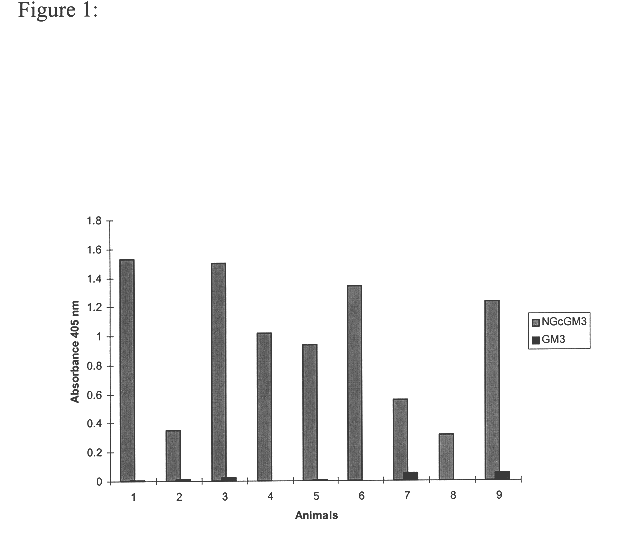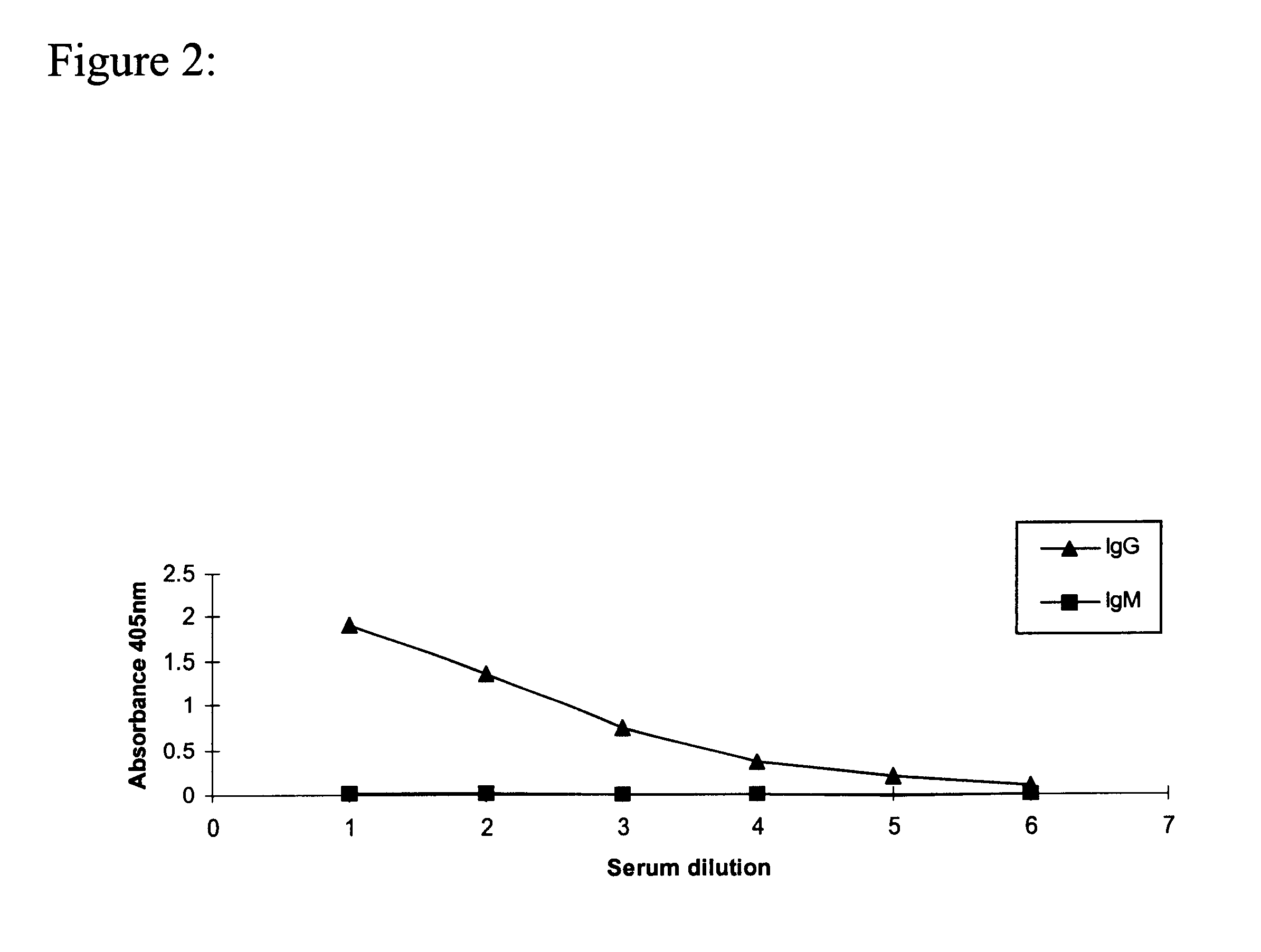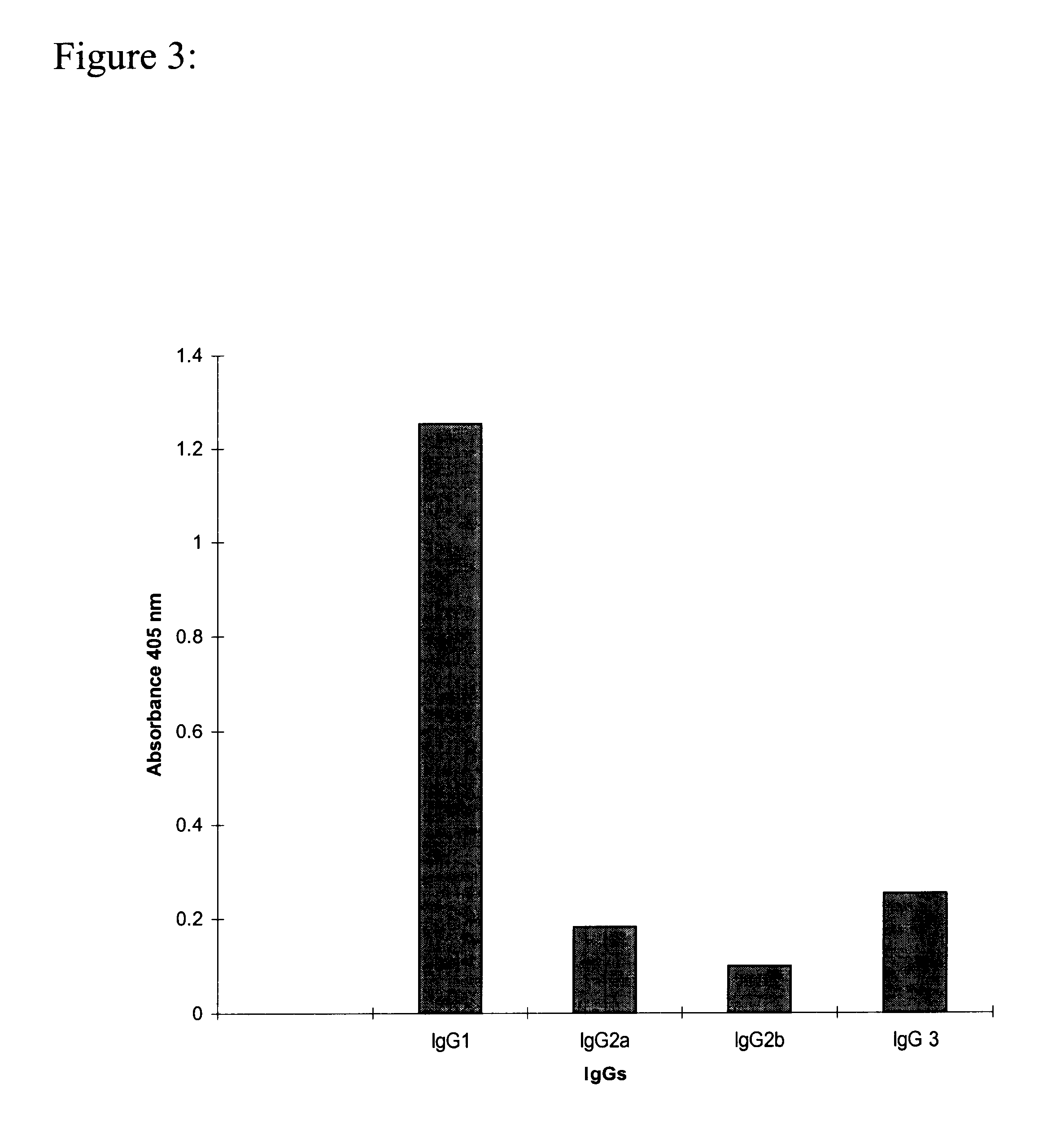Monoclonal antibody which recognizes the oligosaccharide N-glycolylated-galactose-glucose sialic acid in malignant tumors, and composition containing it
a technology of glycolylated galactose and oligosaccharide, which is applied in the field of human immunology and can solve the problems of difficult diagnosis or treatment of igms as radiolabeled mabs, low affinity of igms, and complex possibility of large-scale purification
- Summary
- Abstract
- Description
- Claims
- Application Information
AI Technical Summary
Benefits of technology
Problems solved by technology
Method used
Image
Examples
example 1
Specific IgG Response to NGcGM3, of the Mice Immunized with the Vaccine Preparation NGcGm3 / VLDL / Adyuvant Freund Complex, Measured by an Immunoenzymatic Technique
Female Balb / C mice between 6-8 weeks old were injected by intramuscular route with 0.2 mg of the vaccine preparation human NGcGM3 / VLDL, with the complete Freund adjuvant in the first dose and incomplete Freund adjuvant in the following doses (produced by SIGMA) mixed in equal volumes. Each animal received 6 dose. The first 4 dose weekly and the 2 remaining dose every 14 days. Blood extractions were performed previous to the first dose and every 2 weeks.
The antibody levels were measured in the serum of the animals using an indirect ELISA in Polysorp plates (Nunc trade mark), on which the Gangliosides were immobilized following the method described below:
Gangliosides NAcGM3 and NGcGM3 were dissolved separately in methanol (4 .mu.g / ml) and 50 .mu.l / well were added. The plate was placed at 37.degree. C. during one hour and a hal...
example 2
Achievement of Monoclonal Antibodies Against NGcGM3
The antibodies were generated by immunizing Balb / C mice using the procedure described in Example 1.
Three days before the fusion, the animals were re-immunized with the immunogen NGcGM3 / VLDL, using Freund complete adjuvant. Afterwards mice spleen were obtained and a cell suspension prepared by passing the tissue through a stainless steel sieve or by spleen perfusion. Cell fusion was performed as described by Kohler y Milstein (Nature, 1975, No. 256, 495-497) with some modifications.
The cells of the non secreting P3 / X63 Ag8 6.5.3, murine myeloma were fused with the murine splenocytes in a proportion 1:10, in 0.5 mL of fusion media containing 42% of poliethilenglycol (3000-3600 Sigma)in RPMI 1640 media.
The cells were cultured in HAT (hipoxantine / aminopterine / tymidine) selective media at 37.degree. C., with a humid atmosphere of 5% CO.sub.2, after cell fusion.
Between 10 and 15 days after the cell fusion was performed the assay for detec...
example 3
Determination of the Subclass of the 14F7 Monoclonal Antibody
To determine the immunoglobulin subclass of the monoclonal antibody of this invention an indirect ELISA on plates coated with NGcGm3 was used as described in example 1, but substituting the serum for dilutions of the supernatant of the hybridoma or of the purified Mab.
Biotin conjugated Anti IgG1, IgG2a, IgG2b e IgG3 murine Mabs produced in rats (Pharmingen), diluted in incubation buffer were added. After one hour incubation at 37.degree. C. the plates were washed and alkaline phosphatase conjugated streptavidin diluted in the incubation buffer was added. As controls of each subclass murine Mabs previously characterized were used.
Finally the substrate solution was added. Reading of the absorbance was performed as described before. FIG. 3 shows that the 14F7 Mab belongs to the IgG1 subclass.
PUM
| Property | Measurement | Unit |
|---|---|---|
| time | aaaaa | aaaaa |
| time | aaaaa | aaaaa |
| volumes | aaaaa | aaaaa |
Abstract
Description
Claims
Application Information
 Login to View More
Login to View More - R&D
- Intellectual Property
- Life Sciences
- Materials
- Tech Scout
- Unparalleled Data Quality
- Higher Quality Content
- 60% Fewer Hallucinations
Browse by: Latest US Patents, China's latest patents, Technical Efficacy Thesaurus, Application Domain, Technology Topic, Popular Technical Reports.
© 2025 PatSnap. All rights reserved.Legal|Privacy policy|Modern Slavery Act Transparency Statement|Sitemap|About US| Contact US: help@patsnap.com



